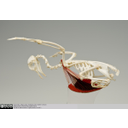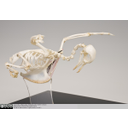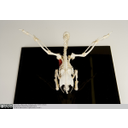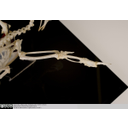Birds
Aves - birds
| Sarcopterygii; Tetrapoda; Amniota; Sauropsida; Reptilia; Diapsida Archosauria; Dinosauria; Saurischia; Theropoda; Aves |
Birds
evolved from a group of small theropod dinosaurs in the Middle-Late Jurassic.
Diversity and Lower
Taxonomy:
The class Aves,
containing around 10,000 extant species
of bird, can be divided into two clades:
- Palaeognathae: Includes the tinamous - 47 species in one family within a single order - and the ratites(flightless birds), containing 5 families - the ostriches, kiwis, rheas, emu and cassowaries. Although previously thought to be separate groups, it has recently been shown that the tinamous are actually embedded within the ratites, thus ratites as they have been traditionally considered are a paraphyletic group, as their most recent common ancestor is shared with the tinamous. The proposed phylogenetic tree for palaeognathans is shown below:

- Neognathae: With nearly 10,000 species, this clade contains the remaining
living modern birds. It splits early to form two taxa, the Galloanserae (ducks, fowl and
their relatives), and the Neoaves.
- The superorder Neoaves contains
26 orders, including many well known groups such as parrots, woodpeckers,
penguins, flamingoes, owls, raptors and
vultures, kingfishers, and the largest, most diverse and recognised group
- the passerine, or perching, birds.
- With around 5,300 species, the monophyletic order Passeriformes makes up over
half of all bird species, including the most popular and studied of all
birds, the songbirds (Oscines),
which are characterised by a complex voicebox used in mate attraction, as
well as territory defence. You probably hear these sounds outside your
bedroom window every morning, as songbirds include many common species
such as robins, blackbirds, magpies, finches and swallows.
- The phylogenetic relationships
of the Neoaves is a hotly debated topic, with many studies currently in progress.
In 2008, Neoaves underwent a major upheaval and reshuffle, based on
genetic studies from Hackett et al. (2008) and Ericson et al. (2006),
placing many groups in dramatically different phylogenetic positions. For
example, the birds of prey, traditionally grouped together in an order
called Falconiformes, has
been split into two separate orders - the new Falconiformes, including
only the single family of true falcons, and the Accipitriformes, containing all other birds of prey, including
hawks, eagles and vultures. Phylogenetically, the new Falconiformes have
been relocated to become the sister clade of the parrots and
the passerines, far away from the Accipitriformes (whose full evolutionary
relationships remain somewhat cloudy).
Features:
- Feathers, which are specialised structures modified from
reptilian scales, for insulation, display, camouflage and flight.
- The insulation from these
feathers allowed birds (and perhaps their dinosaurian ancestors) to become
endotherms - allowing them
to raise their internal body temperature by retaining the heat energy
generated as a by-product of metabolism - a feature they share with
mammals.
- Wings, formed of the humerus,
radius, ulna, wrist and three digits (of these, the first and third are
greatly reduced).
- The first digit forms the alula, a specialised wing slit,
which acts to reduce drag when
flying by keeping air close to the wing.
- Fused clavicles, forming the furcula (wishbone).
- Large keeled sternum (breastbone), for the
attachment of powerful flight muscles. This keel is greatly reduced in
most flightless birds, such as ratites.
- No teeth; replaced by a horny beak.
- Caudal vertebrae are reduced and fused to
form the pygostyle, which
supports the tail feathers.
- Sacral vertebrae fused to form
a synsacrum, which
connects with a broad, elongated pelvic girdle and ossified thoracic vertebrae. These features,
combined with the pygostyle, form a rigid trunk - an important adaptation for flight stability.
- Fused tibia and uppermost tarsals (ankle bones) to form the tibiotarsus - what we call
the drumstick. The fibula is
reduced and spike-like.
- Tarsometatarsus, formed by the fusion of the outermost tarsals with
the metatarsals (toe
bones).
- Reversed hallux (big toe) on feet,
specialised for perching.
- In most birds, many bones, such
as the sternum, pectoral girdle and humeri, are hollow and air-filled,
or pneumatic. These air spaces have two functions:
- They acts to balance out the
overall body weight to keep it relatively light for flight, as the bones
of the hind limbs are usually solid and heavy to position the centre of
gravity on the legs for perching/standing.
- They aid in respiration, by
acting as a space to contain air sacs involved in the one-way (as opposed
to tidal) flow of air through a bird's faveolar lungs.
- They acts to balance out the
overall body weight to keep it relatively light for flight, as the bones
of the hind limbs are usually solid and heavy to position the centre of
gravity on the legs for perching/standing.
Licensed under the Creative Commons Attribution Non-commercial Share Alike 3.0 License
'Vertebrate Diversity' has been released as an open educational resource (OER) on a Creative Commons 'Attribution Non-commercial Share Alike' license. This means that once downloaded, content can be modified and improved to complement a particular course. This requires, however, that improvements are recycled back into the OER community. All content present at the time of download must be accordingly credited and, in turn, novel content must be appropriately licensed. For more information, please refer to the license deed by clicking on the link above.



